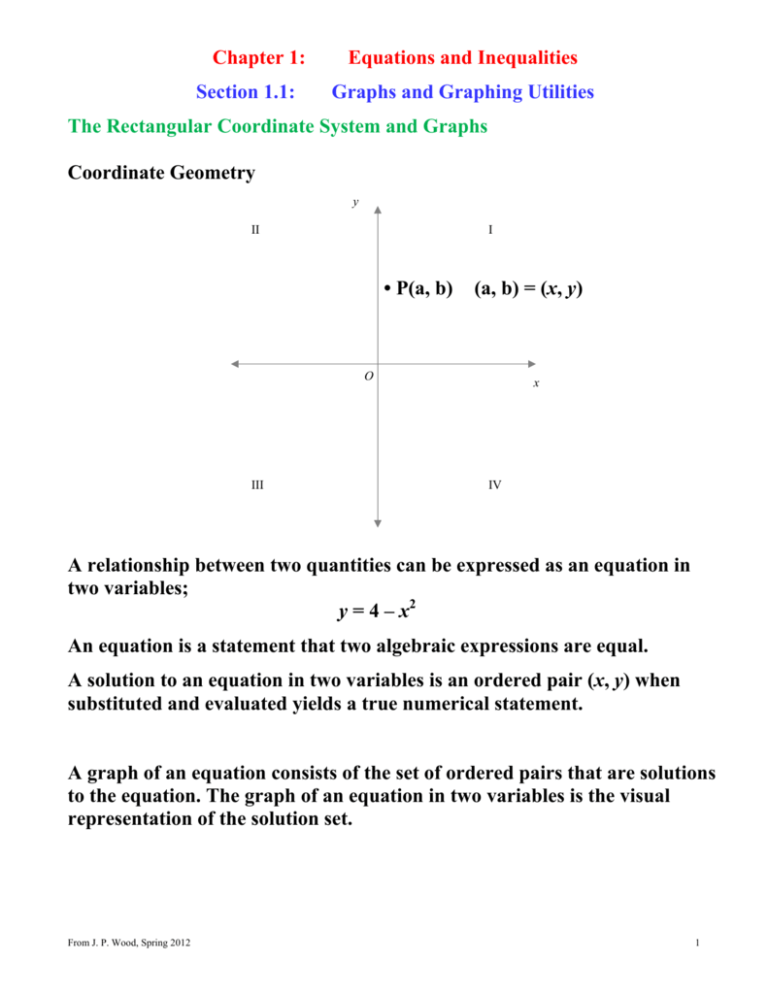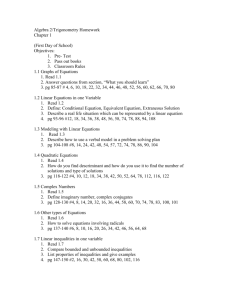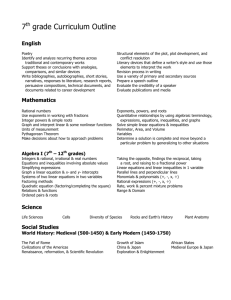Chapter 1: Equations and Inequalities Section 1.1: Graphs and
advertisement

Chapter 1:
Section 1.1:
Equations and Inequalities
Graphs and Graphing Utilities
The Rectangular Coordinate System and Graphs
Coordinate Geometry
y
II
I
• P(a, b)
(a, b) = (x, y)
O
III
x
IV
A relationship between two quantities can be expressed as an equation in
two variables;
y = 4 – x2
An equation is a statement that two algebraic expressions are equal.
A solution to an equation in two variables is an ordered pair (x, y) when
substituted and evaluated yields a true numerical statement.
A graph of an equation consists of the set of ordered pairs that are solutions
to the equation. The graph of an equation in two variables is the visual
representation of the solution set.
From J. P. Wood, Spring 2012
1
y = 4 – x2
Graph the equation:
(1) pick values of x
x y
(2) evaluate y values
(3) plot ordered pairs
(4) smoothly connect dots
Now use TI-83 to graph
To find intercepts:
From J. P. Wood, Spring 2012
x-intercept : set y = 0 and solve for x
y-intercept : set x = 0 and solve for y
2
Section 1.2
Linear Equations and Rational Equations
Definition of a Linear Equation: A linear equation in one variable x is an
equation that can be written in the standard form:
ax + b = 0
a,b are reals, a ≠ 0
A solution to a linear equation is a value of the variable when
substituted and evaluated yields a true numerical statement.
Solving equations centers around generating equivalent equations
(rules on p 102)
Solve the following:
3x – 5 = 7
2(x – 3) – 17 = 13 – 3(x + 2)
Use the TI-83 to verify the solution
Linear Equations with Fractions:
From J. P. Wood, Spring 2012
3
Rational Equations:
A Rational Equation contains one or more rational expressions
Solving a Rational Equation
Solving a Rational Equation to determine when two equations are
equal:
Types of Equations:
An equation that is true for all values in the domain of the variable is
an identity:
x2 – 9 = (x + 3)(x – 3)
A conditional equation is one that is true for some but not all
permissible values of the variable:
2x + 3 = 17
An inconsistent equation is one that is not true for any permissible
value of the variable:
x=x+7
Determine the category (type) of the following equation:
2(x + 1) = 2x + 3
From J. P. Wood, Spring 2012
4
Section 1.3:
Modeling with Linear Equations
Mathematical Modeling: The process of translating phrases or sentences
into algebraic expressions or equations.
Strategy for Solving Word Problems:
1. Read problem carefully and then state in own words what the
problem is looking for. Let x represent an unknown quantity.
2. If necessary write any other unknowns in terms of x.
3. Write an equation in x that models the verbal problem
4. Solve equation to answer the problem
5. Check solution in original wording of problem
Example:
You are choosing between two long-distance telephone plans. Plan A has a
monthly fee of $20 with a charge of $0.05 per minute for all long-distance
calls. Plan B has a monthly fee of $5 with a charge of $0.10 per minute for
all long-distance calls. For how many minutes will the costs for the two
plans be the same?
Example:
Your grandmother has $50,000 to invest and needs your help. Part of this
money is to be invested in noninsured bonds paying 15% annual interest
and the rest of the money is to be invested in a government insured CD
paying 7% annual interest. She wants $6000 per year total interest earned
from both of these investments. How much money should she invest in
each?
From J. P. Wood, Spring 2012
5
Example:
A rectangular family room is three times as long as it is wide, and
its perimeter is 60 ft. Find its dimensions.
Common Formulas (p.123)
For a circular cylinder, write the formula in terms of height.
From J. P. Wood, Spring 2012
6
Section 1.4
Complex Numbers
Let’s solve:
x2 + 1 = 0
For the real numbers a and b, the number
a + bi
is a complex number
a + bi = c + di if and only if
a=c
and
b=d
Operations with Complex Numbers
Addition and Subtraction:
Multiplication:
Division using Complex Conjugates
The Complex Conjugate of
From J. P. Wood, Spring 2012
a + bi
is a – bi
7
Roots of Negative Numbers
Principal Square Root of a Negative Number
−b = i b
Operations Involving Square Roots of Negative Numbers
From J. P. Wood, Spring 2012
8
Section 1.5
Quadratic Equations
A quadratic equation is an equation that can be written in the general form:
ax2 + bx + c = 0
Solving Quadratics by Factoring (rules on p.137)
Remember the Zero Product Principle:
If ab = 0, then a=0 or b = 0
x2 – 7x +10 = 0
Solving Quadratics by the Square Root Property
Extracting Square Roots:
Let u2 = d
If u2 = d
then u = ± d
Solving Quadratics by Completing the Square:
From J. P. Wood, Spring 2012
9
Solving Quadratics by using the Quadratic Formula
−b ± b − 4ac
x=
2a
2
For any
2
ax + bx + c = 0
The radicand of the Quadratic equation is called the discriminant
( Look at Table 1.2 on p.146)
2
b – 4ac
If the discriminant is a perfect square, the quadratic is factorable
12x2 – 10x – 12
4 ways to solve a quadratic:
1. Factor (if factorable)
2. Extract the Root (if in u2 = d format)
3. Complete the Square (always)
4. Quadratic Equation (always)
Pythagorean Theorem
a2 + b2 = c2
c
a
b
From J. P. Wood, Spring 2012
10
Section 1.6
Polynomial Equations
Radical Equations
Equations with Rational Exponents
Solving form:
m
n
x =k
If m is even
If m is odd
Equations that are in Quadratic Form
Equations Involving Absolute Value
Absolute Value:
From J. P. Wood, Spring 2012
If |u| = c
then u = c
or u = -c
11
Section 1.7
Linear Inequalities and Absolute Value Inequalities
Interval Notation:
Open Interval
(a, b) = {x| a < x < b}
Closed Interval
[a, b] = {x| a ≤ x ≤ b}
Infinite Interval
(a, ∞) = {x| x > a}
Infinite Interval
(-∞, b] = {x| x ≤ b}
(More interval notations shown on p.174)
Intersections and Unions of Intervals
Find (1, 4) ∩ [2, 8]
and (1, 4) U [2, 8]
Solving Linear Inequalities in One Variable (Properties of Inequalities p 177)
Addition Property of Inequality
Positive Multiplication Property of Inequality
From J. P. Wood, Spring 2012
12
Negative Multiplication Property of Inequality
Solving a Linear Inequality Containing Fractions
Inequalities with Unusual Solution Sets
Solving Compound Inequalities
Solving Inequalities with Absolute Value
|u| < c
iff
-c < u < c
|u| > c
iff
u < -c
From J. P. Wood, Spring 2012
or
u>c
13







